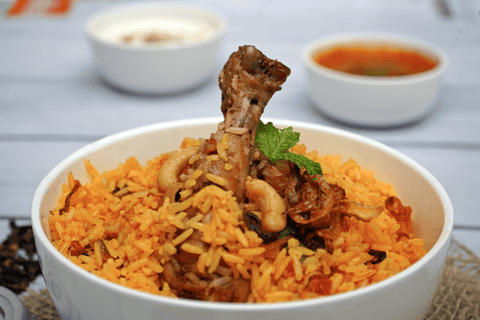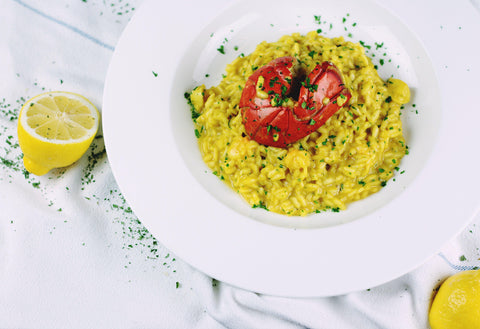Introduction:
Saffron Biryani is a rice-based dish that is popular in the Indian subcontinent and other parts of the world. It is made with long-grain basmati rice, meat or vegetables, and a variety of spices. Saffron is an important ingredient in this dish as it adds a unique flavor and aroma and gives the dish a distinctive golden color.
Here is our favorite recipe of Saffron Biryani:
Ingredients:
- 2 cups basmati rice
- 500g meat (chicken, lamb or beef), cut into bite-size pieces
- 1 cup yogurt
- 1 tbsp ginger paste
- 1 tbsp garlic paste
- 1 tsp cumin powder
- 1 tsp coriander powder
- 1 tsp turmeric powder
- 1 tsp red chili powder
- Salt, to taste
- 2 large onions, thinly sliced
- 1/2 cup vegetable oil or ghee
- 1/2 cup milk
- A pinch of saffron threads
- 2 bay leaves
- 2 cinnamon sticks
- 2-3 green cardamom pods
- 2-3 cloves
- Water, as needed
Instructions:
- Wash and soak the basmati rice in cold water for 30 minutes. Drain the water and set aside.
- In a bowl, mix the yogurt, ginger paste, garlic paste, cumin powder, coriander powder, turmeric powder, red chili powder, and salt to make a marinade. Add the meat pieces to the marinade and mix well. Cover and refrigerate for at least 1 hour or overnight.
- In a large pot, heat the oil or ghee and fry the onions until they are crispy and golden brown. Remove the onions from the pot and set aside.
- In the same pot, add the marinated meat and cook until it is partially cooked, stirring occasionally. Remove the meat from the pot and set aside.
- In the same pot, add the rice, bay leaves, cinnamon sticks, cardamom pods, and cloves. Stir until the rice is coated with the spices.
- Add enough water to the pot to cover the rice by about 1 inch. Bring the water to a boil and then reduce the heat to low. Cover the pot and cook the rice until it is partially cooked, about 8-10 minutes.
- In a small bowl, soak the saffron threads in warm milk for a few minutes until the milk turns yellow.
- In a separate pot, layer half of the partially cooked rice, then the cooked meat, and then the fried onions. Repeat the layers with the remaining rice, meat, and onions.
- Pour the saffron-infused milk over the top of the layered rice and cover the pot with a tight-fitting lid.
- Cook the biryani on low heat for 15-20 minutes, or until the rice is fully cooked and the flavors have infused. Remove from heat and let it rest for 10 minutes before serving.
- Garnish the biryani with chopped fresh cilantro or mint leaves, and serve hot with raita (a yogurt-based side dish) or chutney. Enjoy!

Cultural & History Aspect of Saffron Biryani:
Saffron Biryani is a dish with a rich cultural significance in the Indian subcontinent. It is often served at special occasions such as weddings, festivals, and family gatherings, and is considered a dish that symbolizes hospitality and celebration.
In the Indian subcontinent, biryani has a long history and is believed to have originated in the Mughal Empire. The dish was introduced to India by Persian and Turkic invaders and has evolved over time to include regional variations and ingredients.
Saffron, one of the key ingredients in Saffron Biryani, has a long and storied history in India and has been used in culinary and medicinal applications for centuries. It is considered a luxury ingredient and is often associated with wealth and prosperity.
The preparation of Saffron Biryani is often a time-consuming and labor-intensive process that involves the use of multiple pots and layers of ingredients. It is a dish that requires skill and experience to prepare, and many families have their own recipes and techniques that have been passed down through generations.
Saffron Biryani is not just a dish; it is a cultural expression that brings together family and friends, celebrates special occasions, and connects people to their cultural heritage. It is a dish that embodies the rich culinary traditions and cultural diversity of the Indian subcontinent and is beloved by food lovers all over the world.



